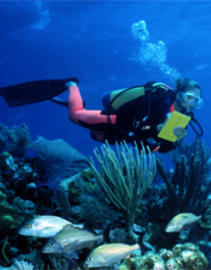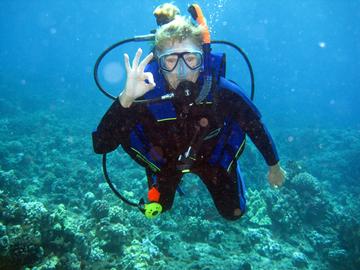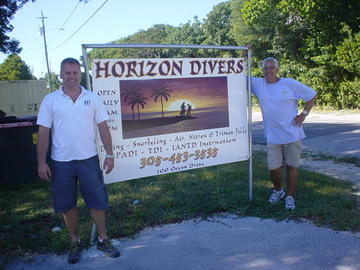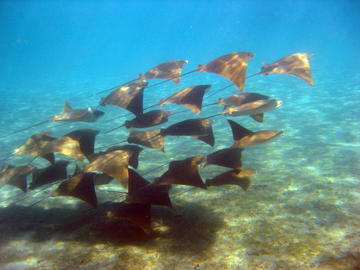Author: Christy Pattengill-Semmens, Director of Science
Every month, scientists, government agencies, and other groups request raw data from REEF’s Fish Survey Project database. Here is a sampling of who has asked for REEF data recently and what they are using it for:
- Researchers at the World Resources Institute are using western Atlantic REEF data in an analysis of threats to the world’s coral reefs called Reefs at Risk Revisited.
- A scientist from Washington Department of Fish and Wildlife is evaluating population trends of rock scallop in preparation for harvest rule updates.
- Researchers from the Puerto Rico and US Virgin Islands GAP Analysis Project are creating species range maps that will be used with habitat information to model species distributions. The goal of this project is to keep common species common by identifying those species that are not adequately represented in existing conservation places.
- A researcher from Cascadia Consulting Group is using data on three invasive tunicate species collected by REEF surveyors in the Pacific Northwest to prepare for a baseline assessment for the Washington Invasive Species Council.
Author: Sasha Medlen, REEF Membership Coordinator
REEF members are at the heart of our grassroots marine conservation programs. Over 43,000 divers, snorkelers, students, and armchair naturalists stand behind our mission.
This month we highlight Flo Bahr (REEF member since 2001). Flo lives in Kihei, Hawaii, has conducted 186 REEF surveys, and is a Level 5 Expert surveyor. Along with Rick Long and Liz Foote, Flo helps organize the Fish Identification Network (FIN) on Maui. FIN provides an opportunity to join friends and fellow fish lovers in exploring the coral reefs of Hawaii. Maui's original FIN founders, Mike and Terri Fausnaugh, have since started FIN on Oahu. There are monthly, sometimes weekly, dives at various beaches. At every event, volunteers set up a REEF station with survey materials and identification reference guides in an attempt to lure in new afishionados! Here’s what Flo had to say about diving with REEF:
When and how did you first volunteer with REEF or become a REEF member? How did you first hear about REEF?
Way back in 2001, Liz Foote introduced me to REEF. She was so enthusiastic and knowledgeable about the ocean and fish that it encouraged me to learn more. Being relatively new to living on Maui, I had a lot to learn. Fish card in hand, I tried to identify and learn at least two new fish each time I went snorkeling or diving. I had a screensaver on my computer that flashed fish pictures and their names, the latest fish identification books and friends to debrief with after snorkeling and diving.
What is your favorite part about being a REEF member?
The friendships I have developed and “talking fish” with friends has become my favorite part of doing REEF surveys. We even started a club called FIN, for Fish Identification Network, and we meet once a month for REEF surveys, socializing, and FOOD. The club is open to anyone who has an interest in fish, and we have a nice, flexible group. New people swim along with more experienced surveyors, and we all have fun after with eating and talking about what we saw that day.
In your opinion, what is the most important aspect of REEF’s projects and programs?
The fun and friendships are great, but the REEF surveys are so valuable to scientists, students, and other avid fish folks. There is just not a wealth of information about what fish are where and in what quantities, so our data can be helpful in determining the health of our declining reefs and can also give swimmers an idea of what might be seen in different areas.
What is the most fascinating fish encounter you’ve experienced? Is there a fish you haven’t seen yet diving, but would like to?
There are so many cool and surprising things to see in the ocean. Just last week, at Maonakala while snorkeling, we saw a Coronetfish taking a ride on a turtle. A couple of months ago while diving at Wailea Point, we saw a turtle with a strange lump on its back that turned out to be a resting Flowery Flounder. As for what I want to see -- a seahorse! Recently we were diving Wailea Point because of reports of seahorses being seen by a few divers. We searched and searched while diving in just 10-15 feet of water. We couldn’t find them but will keep on looking until we do. It will be so cool when I find a seahorse and get to add it to my survey!
Author: Alecia Adamson, REEF Field Operations Coordinator
REEF is proud to partner with over 130 dive shops, dive clubs, individuals, and other organizations as REEF Field Stations.
This month we feature Horizon Divers in Key Largo, FL. Just down the street from REEF Headquarters, they have been a long-time supporter of REEF’s efforts. One of their hallmark efforts is supporting the REEF Marine Conservation Internship Program by allowing REEF Interns to come out on the boat for free and conduct fish surveys. Horizon dive instructor, Mike Ryan, says, “It’s a lot of fun having them out on the boat regularly and getting to know them. When other divers see their slates and see them tallying fish underwater, they become curious and often ask the interns what they are doing and why count fish. The interns are great because they have the ability to inspire divers to learn fish names and start surveying which, in turn, brings us more business!” Mike also gets into REEF surveying himself. When asked about his best lifetime sightings, he quickly said they were a Manta Ray at one of their popular dive sites and a resident Longlure Frogfish that was regularly surveyed on the Speigel Grove for nearly a two-year timespan.
Horizon Divers regularly teaches fish identification specialty courses and always encourages their students to become REEF surveyors. The shop is also very active in REEF’s Lionfish Control Program in the Keys. Most of their staff have been through REEF’s Lionfish Collection and Handling Workshop and they hold current permits to collect lionfish in the no-take Sanctuary Preservation Areas (SPAs). The dive shop also serves as a Lionfish Collection Bank, collecting, labeling, and storing collected lionfish until they pass them to REEF for research purposes. Mike recently developed a “Lionfish Safari” PADI specialty course. Mike says, “Although lionfish are an ecological nightmare, we are trying to make the best of it by engaging divers in lionfish control efforts and drumming up business at the same time.”
Author: Christy Pattengill-Semmens, Director of Science
World-wide declines in shark and ray populations have prompted the need for a better understanding of their patterns of distribution and abundance. While much of the focus has been on the larger species of sharks, little attention had been paid to the most frequently sighted elasmobranch species in the greater-Caribbean, the yellow stingray (Urobatis jamaicensis). Despite being relatively common and listed as Least Concern on the IUCN Red List, little was known about the status of this species. Unfortunately, it has been quietly declining. Dr. Christine Ward-Paige and her colleagues at Dalhousie University worked with REEF's Director of Science, Dr. Christy Pattengill-Semmens, to examine the status of yellow stingray. The results of this study were recently published in the scientific journal, Environmental Biology of Fishes. Click here to read the paper.
The study used 83,940 surveys collected by REEF surveyors in the western Atlantic. In total, yellow stingrays were observed on 5,658 surveys (6.7% sighting frequency) with the highest occurrence in the regions surrounding Cuba. Overall, sighting frequency declined from 20.5% in 1994 to 4.7% in 2007. However, these trends were not consistent in all regions. The strongest decline occurred in the Florida Keys, the most sampled region, where trends were similar among all areas, habitats and depths. Possible explanations for these changes include habitat degradation, exploitation (this species is collected for medical research and the aquarium trade), and changes in trophic interactions. The results of the study suggest large-scale changes in yellow stingray abundance that have been unnoticed by the scientific community. This study also highlights the value of non-scientific divers for collecting data that can be used to understand population trends of otherwise poorly studied species.
To see this and other scientific papers that have been published using REEF data, check out the Publications page on the REEF.org website here.
Author: Mike Phelan, REEF Advanced Assessment Team Member
Some of the best dive sites for fishwatching are in the least obvious places. The Blue Heron Bridge in Palm Beach, Florida, is one such biological hotspot. This is a top dive destination for sighting unusual species that can be added to your lifelist. Mike Phelan, REEF Expert surveyor, and two other REEF members, often dive this site. The day before Thanksgiving, they were treated to quite a sight – a large school of Cownose Rays! This is a rare sighting in Florida, but it’s just another day at the Blue Heron Bridge. Some of the more unusual and recent sightings include the Blackwing Searobin, Roughtail Ray, Northern Stargazer, Orangespotted Blenny, Polkadot Batfish, and the Chain Pipefish. The bridge traverses a small island located in the inland waterway near the Lake Worth inlet. The dive sites consist of a variety of eco-niches such as sand, shell rubble, sea grass, algae hydroid fields, sailboat mooring lines and anchors and of course bridge pilings and concrete rubble. The Blue Heron Bridge has over 282 species recorded in the REEF database and the number is increasing monthly (click here to see the full list).
The actual dive site is a local county park named Phil Foster Park that is protected with a no-take ordinance. All dives are shore-based and must be timed with the high tide. The dive can be safely done by entering the water one hour before high tide and exiting one hour after high tide. Depths range from 8 -17 feet and the water is usually clear even if the off-shore ocean is rough. Remember to bring a dive flag. Many divers combine their Blue Heron trip with some local Jupiter off-shore diving to witness the Goliath grouper aggregations in August or September, Loggerhead, Green, and Leatherback turtle nesting during the spring or the Lemon shark aggregation in the winter. This is certainly a dive site to be thankful for!
Do you have a dive site story that you would like to share? Email us.









